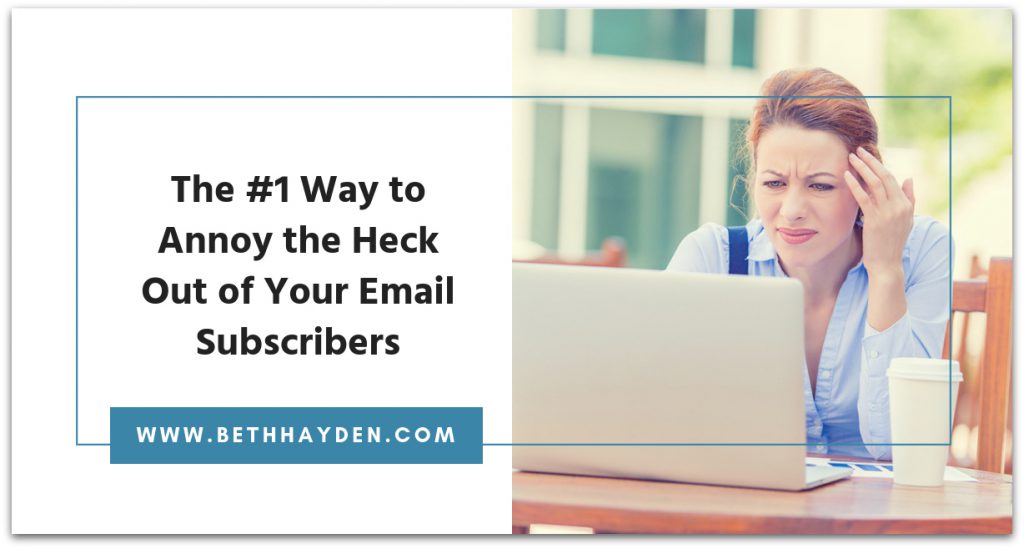
I recently started eating fewer carbs and following a ketogenic diet. It’s a pretty radical change for me.
And I’m not going to lie. The biggest thing I miss is….pizza.
Pizza used to be my favorite food. I would eat it every day if I could.
But regular pizza crust is definitely on the “no” list for low carbers, so I had to either give it up completely, or find a low-carb substitute.
I have been fiddling around with different online recipes for pizza crusts, but all of the crusts I made at home just tasted gross to me.
So I recently discovered a pre-made, low-carb pizza crust you can buy online. The product reviews on the company’s website are great, so I ordered a few of the crusts to test them out.
What does this have to do with online marketing, you ask?
Here’s how it ties in: This company made a critical error in their email marketing strategy, right after I placed my order, and it was so blatant and flat-out annoying that I decided to feature them in a “What Not to Do with Your Email Marketing” blog post.
Here’s What the Low-Carb Pizza Company Did Next
I had just placed my order, and was excited to receive my pizza crusts.
At this point, I’m a warm audience member for this company, and I’d love to get to know them better and receive more information about what they do and how they make their low-carb products.
About a day after I placed my order, I got this email from the pizza crust company:
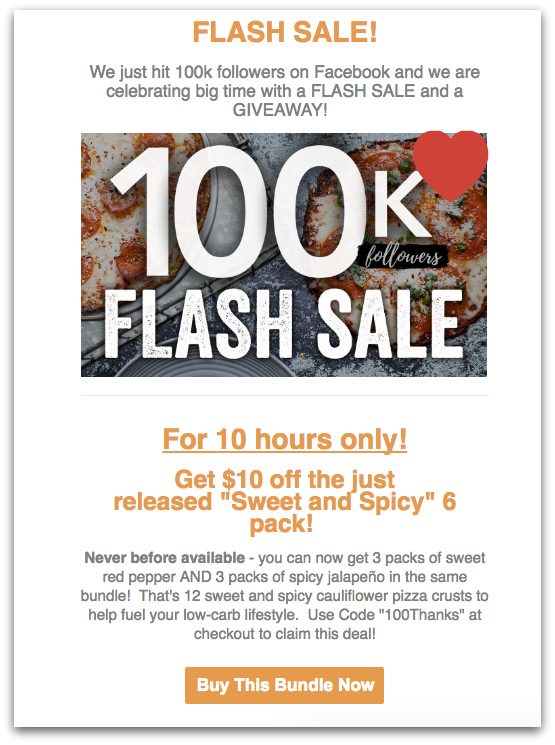
Then two days later, I got this email:
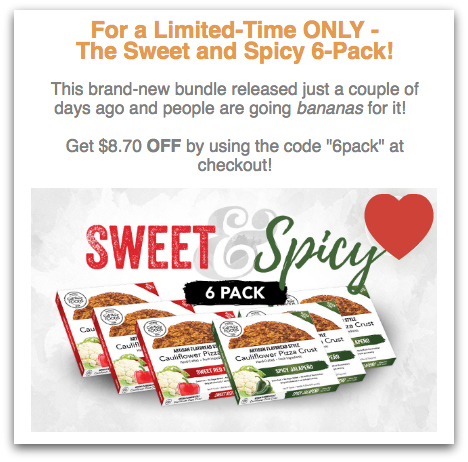
Are you starting to see a pattern? Have you spotted the mistake yet?
One more, just for good measure.
Here’s the email I received 3 days after my order:
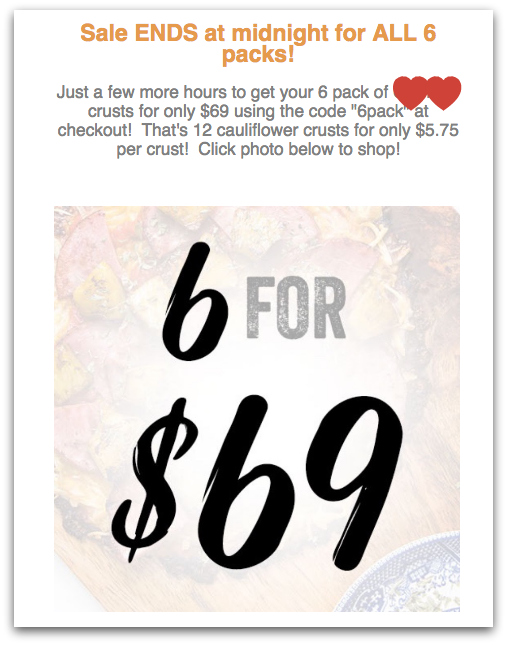
See the problem yet?
The Mistake This Company Made, and Why It Annoyed Me Enough to Write an Entire Blog Post About It
The biggest problem isn’t that they sent me three emails in short succession after I placed my order. That’s fine – I understand that the first few days after a customer buys from you is a great time to reach out and try to get them to purchase more items.
The problem is that these emails were all about selling. It’s all about them (the company), not about their target audience member (me).
During those first few days, when I was excited about the company and its products, and I was looking forward to getting interesting information, they sent me a sales pitch. And another one. And another one.
After the third sales email, I unsubscribed.
I didn’t want to get bombarded with constant sales messages. I get enough of those emails already, just like everyone else in the world.
This company lost a subscriber when they made this critical error, and because I unsubscribed, they gave up the ability to follow up with me, build a relationship, and stay at the top of my mind next time I want to order more low-carb products.
Here’s What This Company Could Have Done Instead
Wondering what they could have done instead?
They could have sent me useful content.
Useful content – like blog posts, videos, or podcast episodes – is the kind of content that gives me real-world information that improves my life in some way.
This is the kind of content that consistently builds relationships with potential buyers, increases authority in their industry, and brings in more revenue.
And there was a LOT of opportunity for this company to get it right with their email marketing strategy.
Low-carb diets and keto diets have become quite popular recently. Because this company’s products are specifically marketed as low carb (and great for the ketogenic diet), their marketers had a fantastic opportunity to create and send all kinds of helpful info that would have helped me in my journey.
This company could have included any of the following in their follow-up emails to me:
- Articles and blog posts about the low-carb way of eating.
- Recipes for low-carb pizza and flatbread sandwiches.
- More information about the science of low-carb eating.
- Advice on dealing with cravings, holiday eating, or pressure from family members.
- Links to useful podcasts about the ketogenic diet.
- Recommendations for books, videos, or magazines.
They also could have easily followed up with me after my order arrived, to see if I liked their product or ask me if I had any questions.
If this company had sent me anything useful in their first few emails, they would have kept me as a subscriber.
Instead, they sent me three sales pitches, in a (futile) effort to get me to buy more products before I’d even had the chance to even taste my first order.
Do You Make This Mistake?
I know people get really upset when their subscribers leave their mailing lists.
As a copywriter, I tell my clients not to worry about numbers, and I always explain that people who unsubscribe aren’t their target audience members, anyway.
But in this case, I do want you to take a minute and evaluate what you’re sending out to your email list, especially right after people buy from you or sign up for your list.
Are you sending constant sales pitches and discount offers?
Or are you sending useful content that your subscriber will find interesting and helpful?
If all you’re doing is selling, selling, selling, it’s quite likely your emails are doing more harm than good. It’s time to re-evaluate your strategy.
If you want to make a change for 2019, consider creating content that will help you build a long-term, trusted relationship with your new subscriber.
Because in the long run, that relationship is all that really matters.
And if you annoy your customer so much that they unsubscribe after only three emails, you’ve missed the mark – and lost the opportunity to connect with someone who could potentially buy from you again and again.
Having trouble writing emails that connect? I can help.

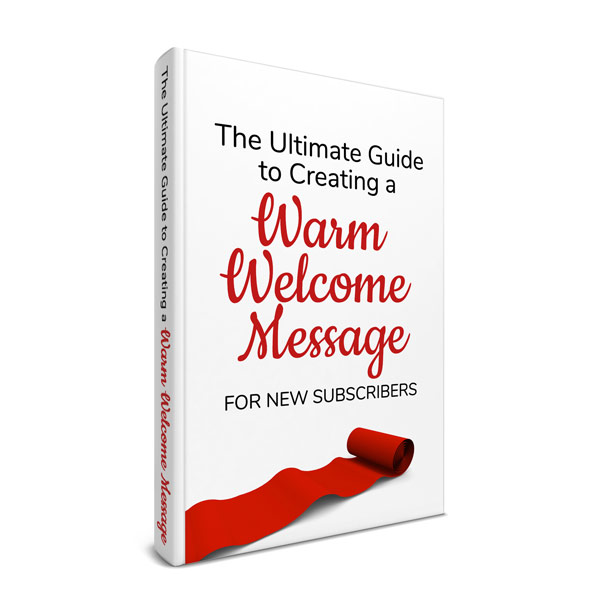
14 thoughts on “The #1 Way to Annoy the Heck Out of Your Email Subscribers”
Also, and on a less subtle note, those emails just hurt my eyes. They reminded me of the ads that pop up sometimes when I’m trying to get to a website. I mind less being sent “sales” emails if they’re attractive and nice to look at (this does sometimes mean that there’s some content there, now that I think about it). Grove Collective does a nice job of this, for example. I read their emails and often click through to buy. Anyway, I’m not in marketing or sales so I don’t usually think through the “why” of what I do and don’t like – but those emails you showcased made me flinch and want to run away!
I completely agree, Jess! I don’t know why companies even send emails like this…I’d like to see the conversion numbers, to see if they bring in any sales at all. My guess is no…
Maybe…
…Just maybe, you’re not the ideal lead?
Truth is, an ideal lead would always stick around, no matter the number of promotional emails that come in.
As long as it doesn’t get spammy. (Giving the space in-between the mails, this isn’t spammy)
Think of it this way; you LOVE pizza, and you eat it every day, would you unsubscribe from that newsletter if you spend on pizza every day?
I bet you would see it as an opportunity to grab some deal and save a bit on your daily expenses.
I agree that value is of great importance, but I am also of the opinion that, email marketing should be about email MARKETING.
The end goal is to SELL, if you really want to know about all the topics you listed above, you know where to go and get the right information.
Subscribers should know that from the get-go, if they’re okay with it, they stay, if not, then just maybe they’re not the right lead?
A little option on the optin form to decided if you would love to get promotional messages from them or not would have created room for discernment.
No matter the number of “valuable contents” that you get from them, you won’t change you pizza eating habit because of it. It won’t make you order more or consistently, because that’s not the role they’re meant to play in the cycle.
Their role is to tell people that LOVE pizza, how to save on their expenses.
Augustus:
I disagree with your comment. Yes, the goal of email marketing is to sell, but the best way to do that isn’t sending a constant barrage of sales-only emails. Companies make far more sales over time by focusing on building trust.
Ok – but how was the pizza? Was the product good enough to convert you as a repeat customer regardless of the ridiculously spammy and tragic email marketing campaign?
It was pretty good, Chad! I liked it. But interestingly, I haven’t bought from them since then. Not out of spite over the email marketing mistake…just because I haven’t thought of it! Which proves my point, in this very tiny, N=1 case study.
“The biggest problem isn’t that they sent me three emails in short succession after I placed my order. ” That may be fine for you and others. However, for me and the thousands of subscribers on my lists “cascade” email marketing as I call it has become a problem. In it’s infancy email marketing to proclaim a message was a novelty. Then advent of spam and the misinformation on what exactly IS spam added another layer to what is now become a “time monger”. Even while pruning down the number of people whose list’s I opted into, the advent of “funnels” has created a cyclical bombardment of “noise” even if some of it is beneficial. Also, the propaganda promoted by most email marketing “experts” that building lists is the ONLY way to have a sustainable online business perpetuates the “time mongering”.
I disagree with many of your points about email marketing, Yancy, but you absolutely have the right to your opinion. It sounds like this is a major frustration for you. I do agree that email list building is not the ONLY way to build a business. But for many companies, it is one of the best ways.
Also, you and Chad may want to review this article that exposes the myth and lies about “WHAT IS SPAM?” http://www.ibosocial.com/yvoncey/pressrelease.aspx?prid=423950
Regards
By the way the is Yancey not Yancy ;0)
I don’t mind receiving emails from the online shopping sites that I use, Beth, provided there is a reason for their emailing me. Otherwise I delete the unopened email without thinking twice.
When it comes to my own list, I’ve established a routine of a weekly Monday email with some insight or a link to a post that is useful. Then around the latter half of the week, I’ll send out an email with a resource whether free or paid, mine or another persons that is aligned with my business and can be useful to the reader but this is segmented for the lead magnet they signed up for. It’s a better balance because I don’t want anyone to unsubscribe thanks to email overwhelm. 🙂
PS. I love pizza too.
I think she’s exactly the ideal lead, and the company blew it because they were so interested in SELLING that they forgot LISTENING and THINKING and other important elements of marketing.
This promo was clumsy. There’s no excuse in 2019 to treat a recent customer like some rando on the street who might want a deal. This was a segmentation fail, a messaging fail, a strategy fail, and a sales fail.
I could think of about 10 different ways to write this campaign that would be less obnoxious, would respect my customer, and would get results, and trust me, I am not afraid to sell.
You said yourself — the goal is email MARKETING. You didn’t say the goal is email SELLING.
Marketing is about creating your place in an industry. It’s about telling the story of your company and how it can improve the lives of your customers. It’s about developing relationships with your people.
Beth *is* their ideal customer: a pizza lover who is trying to eat healthier. She’s already in their pipeline as a buyer! If they’d sent recipes about how to use their crust, or suggestions about how to eat keto/low-carb in public, or recommendations for different baking methods … that would be more compelling that 3 straight days of coupons that devalue their brand.
If they had provided useful content instead of hard sales — something like recipes — they could have easily convinced Beth to buy more of their product (even full price!) to try out those new options. But instead, she felt overwhelmed and backed out of the process. Sort of like a car salesman who tries to force you to buy the first car you look at instead of giving you time to test drive to find the best fit for your lifestyle.
If I’m a suburban mom who wants to buy a minivan, then I could be an “ideal lead” to that car salesman, and you say that I should stick around with that process “no matter” how the sales process goes. But if that salesman is trying to get me to buy a sports car, I’m getting out of there.
This type of email “marketing” is primitive at best, and offensive at worst.
Hi Beth.
Great article.
I unsubscribed from a pizza chain a couple of years back for the same reasons…
I don’t mind receiving emails from brands I like, but there needs to be some value in it. A style guide, tips, hacks etc. Build a relationship. Improve the life of the customer.
I’m much more receptive to a sales pitch from a brand I value.
Am I asking too much? I don’t think so. There’s so much choice these days.
I’m a big fan of recipe suggestions and food hacks. That would have been perfect.
Thanks again. Definitely food for thought.
Comments are closed.